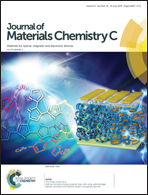Carboxylic ester-terminated fulleropyrrolidine as an efficient electron transport material for inverted perovskite solar cells†
Abstract
The interfacial contacts between perovskite crystals and metal electrodes play a significant role in efficient charge transfer in perovskite solar cells (PSCs). In this work, C60 pyrrolidine tris-acid ethyl ester (CPTA-E) has been employed to form a uniform electron transport layer (ETL) covering the perovskite surface in p-i-n-structured PSCs to replace the traditional (6,6)-phenyl-C61-butyric acid methyl ester (PCBM) ETL. X-ray photoelectron spectroscopy analysis of the perovskite/CPTA-E interface reveals that there are strong coordination interactions between the perovskite and CPTA-E, which are beneficial for the adhesion of the CPTA-E ETL on the perovskite surface. On the other hand, steady-state photoluminescence and time-resolved photoluminescence studies of the perovskite films with different quenching layers confirm that CPTA-E ETL has a preferable charge quenching effect compared to the PCBM ETL, which suggests that the CPTA-E ETL has a superior electron extraction and transport ability. The corresponding CPTA-E ETL-based device exhibits a champion power conversion efficiency (PCE) of 17.44% with less hysteresis. Moreover, the steady-state photocurrent output of the CPTA-E-containing PSC is prolonged compared to that of the PCBM-based device. Therefore, this work provides a viable strategy to design suitable electron transport materials for high-performance PSCs.



 Please wait while we load your content...
Please wait while we load your content...